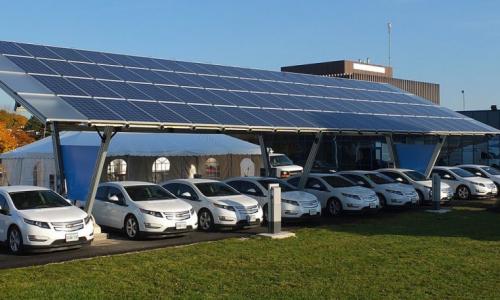Table of Contents
Are you considering buying an electric car? Do you want to know more about how EV charging works? There are several ways you can charge an EV. Each one requires different types of plugs, and their charging times, cost and potential savings vary. The type of charge you choose will depend on your driving needs.
How do I plug in?
The easiest option to plug in an EV is to recharge at home, if you have the ability to park near an electric outlet or can place a new outlet near your parking spot.
All home charging options (with the exception of Tesla vehicles) use a standard EV plug to connect to the car. The other end of the charging cord can either be hardwired or plugged into an existing outlet.
Home charging can use either a 120 volt outlet or 240 volt circuit (like an electric clothes dryer uses). Since almost all EVs include a 120 volt charging cord and 120 volt outlets are common, this is likely the cheapest and easiest option.
Using a 240 volt outlet or circuit requires the purchase of a home charging unit and possibly the need for modifications to the home electric system. However, using a charger powered by a 240 volt circuit has the advantage of charging much faster, from 2 to 8-fold faster depending on the amperage and vehicle.

What are the types of charging?
Level 1—Home Charging: Level 1 charging cords are standard equipment on a new EV. Level 1 charging only requires a grounded (three-prong) 120V outlet and can add about 40 miles of range in an eight-hour overnight charge. Overnight Level 1 charging is suitable for low- and medium-range plug-in hybrids and for all-electric battery electric vehicle drivers with low daily driving usage.
Level 2—Home and Public Charging: Level 2 charging typically requires a charging unit on a 240V circuit, like the circuit used to power a common electric clothes dryer. The charging rate depends on the vehicle’s acceptance rate and the maximum current available. With a typical 30 amp circuit, about 180 miles can be added during an eight-hour charge.
Level 2 chargers are the most common public chargers, and you can find them at places like offices, grocery stores, and parking garages. Public Level 2 chargers have a standard EV connection plug that fits all current vehicles, except for Teslas, which require an adapter.
DC Fast Charging—Public Charging: DC fast charging is the fastest currently available recharging method. It can typically add 50 to 90 miles in 30 minutes, depending on the station’s power capacity and the make of EV.
Tesla’s Superchargers are even faster, adding up to 170 miles of range in a half hour. DC fast chargers are most useful for longer trips, cars in use most of the day (like taxis), and drivers who have limited access to home recharging.
DC fast chargers use three different plug types and are not interchangeable. Japanese automakers typically use the CHAdeMO standard; most European and US makers use the CCS system. Tesla’s Supercharging stations use a proprietary connector specific to their vehicles.
How long does it take to recharge?
The length of time required to recharge depends on two factors: how much energy has been used and the power output of the charger. A Level 1 charger (120 volts) can replace about 4-5 miles of driving each hour of charging. Plug-in hybrid vehicles often have an electric range of 20-50 miles, so recharging even a fully depleted battery can be done in eight hours. Level 2 chargers are faster, delivering about 15-25 miles of range per hour. These chargers can fully recharge most long-range battery electric vehicles during an eight-hour charge. Using a DC fast charger allows for rapid recharging at public stations, adding 50 to 170 miles of range in 30 minutes (depending on the power output of the station and vehicle capacity).
It’s important to note that most drivers will go less than 50 miles a day, so even a relatively slow Level 1 charger will meet the daily recharging needs of most people wanting to switch from gasoline to an electric car.
How much will it cost to charge?
The cost to charge an EV varies, depending on your local utility and ability to charge at home. In our recent analysis of home recharging costs, we found that recharging an EV was substantially cheaper than the costs to refuel the average new gasoline car. The savings vary, but on average drivers would save almost $800 per year by switching from gasoline to electricity.
However, where you live and what electric rate plan you choose can change your savings. For almost all EV drivers, choosing a time-of-use (TOU) electric rate plan is needed to see the largest savings.
A TOU plan gives cheaper electric rates during off-peak periods (often late at night), with higher rates for using electricity during high-demand times. Because most EVs are parked at home overnight, TOU rates are a good fit for most EV drivers.
In some cities, especially in California, TOU rates are essential for saving money on fuel costs. For example, in Oakland, CA, recharging using the standard electricity plan is equal to buying gasoline at $3.34/gallon, while using the TOU plan only costs the equivalent of $1.03/gallon.
The costs to charge at public charging stations varies considerably. Some stations are free, while others can cost over twice as much as home charging. However, the impact of public charger costs is often muted by the high preponderance of home charging. For example, a San Francisco driver that uses higher-cost DC fast charging for 20 percent of charging would only see their average fuel costs increase from $0.78/gallon equivalent to $1.35/gallon.
Learn more about electric vehicle technology and batteries, including materials, costs, and lifespans.




